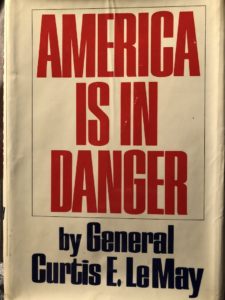 When I was a boy, I remember having civil defense drills in our grade school.
When I was a boy, I remember having civil defense drills in our grade school.
“Why are we crouching under our desks?” I’d ask.
“Because there could be a nuclear war between us and the Soviet Union that will destroy the world. We want to take safety precautions.”
What a way to grow up: under the shadow of nuclear holocaust and defense measures that seemed absurd to even a third grader.
Welcome to the Cold War. It heated up in Viet Nam, where U.S. forces conducted a “counterinsurgency war” against a country, according to General Curtis LeMay, we could have destroyed in a matter of days without a single casualty … or not bothered to fight at all.
Military Minds Versus Political Minds
 In his book America Is in Danger, LeMay lays out his views on war, politics and U.S. military strategy. A great deal of attention is devoted to Viet Nam and to our Cold War policy of deterrence. LeMay was a distinguished U.S. Air Force general who was definitely not one to pull his military punches. Though often caricatured as a mad bomber, LeMay reveals himself as something quite different in the book, a patriot with compassion to go along with his icily practical outlook on military matters. Among his rather sensible ideas —
In his book America Is in Danger, LeMay lays out his views on war, politics and U.S. military strategy. A great deal of attention is devoted to Viet Nam and to our Cold War policy of deterrence. LeMay was a distinguished U.S. Air Force general who was definitely not one to pull his military punches. Though often caricatured as a mad bomber, LeMay reveals himself as something quite different in the book, a patriot with compassion to go along with his icily practical outlook on military matters. Among his rather sensible ideas —
- If we fight a war, we should fight to win as quickly and decisively as possible.
- Our military capabilities should be flexible, integrated and second to none — as this is the best way to deter conflicts.
- We should not be the world’s policeman, but base our decisions to engage militarily on our best interest (which, as he points out, sometimes means staying the hell out of the fight).
- Developing new military technologies and capabilities is a must. If we stop, other countries will surpass us, endangering us and undermining stability around the world.
- Nuclear proliferation is a given. It cannot be stopped, so it must be accounted for in our military and diplomatic strategies.
In contrast to his practical military perspective, LeMay observes this about the political atmosphere —
“Our leaders in the Johnson Administration are unusually concerned with world opinion. They are most sensitive to criticism from the foreign press and attempt to present a benign and peaceful image of America while fighting a war …We are attempting to dress and undress at the same time.”
The brunt of his criticism is directed at Johnson’s Secretary of Defense, Robert McNamara. By methodically breaking down the numbers, LeMay demonstrates how McNamara manipulates statistics to confuse and outright mislead the public with respect to U.S. and Soviet military capabilities.
Beyond this political shell game, and even worse, LeMay believes prevailing political and military strategies are being formulated by amateurs and dreamers whose assumptions are pure fantasy, with no foundation in history or even common sense. Concepts such as unilateral disarmament and nuclear treaties without inspections have us leading with our chin, inviting a knockout punch. America is in danger. And the real enemy, as LeMay intimates, is not North Vietnam or even the Soviet Union. Instead it is the internal conflict between U.S. military and political thinking. America Is in Danger may be one of the most frightening books I’ve ever read. It reads like Dr. Strangelove, only without the comic overtones.
Are military and political minds on the same page today? It’s hard for the average person to know who and where our allies and enemies are. The past two decades have seen us bogged down in land wars (what LeMay would call limited wars), with questionable goals and questionable allies. And for all the labeling of LeMay as a trigger happy war monger, these recent conflicts are exactly the sort of thing LeMay cautioned against. For all our military might, can anyone say with certainly whether we are gaining or losing ground in terms of achieving global stability and national security?
Fight, Flight or Fold?
Confusion aside, there’s no getting around the fact that the whole of human history is one armed conflict after another.
How do we respond to this?
We can fight, we can run, or we can surrender.
General LeMay is obviously a fighter. As chilling and coldly calculating as some of his assessments are, I can’t help but think, I’m glad this man was on our side. Because sure as shooting, there were and always will be men like him on the other side.
In the generation that followed LeMay’s, running was a popular response — turn on, tune in, drop out. Why so many Boomers opted for sex, drugs and rock and roll is attributed to a variety of causes, from being pampered to being victims of government manipulation. But growing up with nuclear safety drills in grade school and so much more, is it any wonder so many wanted to escape?
These days, the question is, are we tired of running and making ready to surrender? And if we are ready to surrender, do we know what it is we are surrendering, and to whom we are surrendering it?
One can certainly make the case for fighting the enemy, or at least being ready to fight the enemy. One can also make the case for retreating, and by some lights, outright surrender presents itself as the preferred course of action. What cannot be argued, though, is to undertake all three at the same time, which is exactly what is happening now. Our war machine grinds on, as we seemingly pick just enough fights around the world to keep the machine oiled and the military-industrial dollars flowing. There is also a rather large bloc advocating isolationism — complete withdrawal from foreign military commitments. And finally, there are those who advocate for totally open borders, cultural capitulation and an end to national identity altogether.
It is doubtful these three attitudes can peacefully coexist for long.
